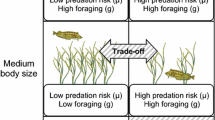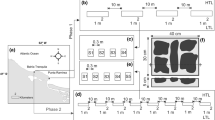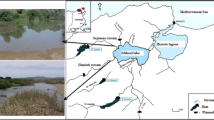Abstract
Shallow shore zones are generally considered to provide juvenile habitats for many invertebrate and fish species and additionally serve as spawning grounds for important components of oceanic food webs and fishery resources such as herring (Clupea spp.). Herring attach their demersal eggs to benthic substrates, rendering reproduction success vulnerable to environmental changes and local habitat alterations. However, little information is available on the effects of different substrates on the survival of demersal eggs. Hypothesizing that the structural complexity of spawning substrates generally affects herring egg survival and that the effect magnitude depends on the suitability of ambient environment, field experiments were conducted on a major spawning ground of C. harengus in the Southwestern Baltic Sea. Herring eggs were artificially spawned on substrates of different structural complexities and incubated in situ under differing temperature regimes, at the beginning and the end of the natural herring spawning season, to include the full suite of stressors occurring on littoral spawning beds. Results of this study indicate a positive relation between high structural complexity of spawning substrates and herring egg survival. Mean egg mortality was three times higher on substrates of lowest complexity than on highly complex substrates. These differences became even more prominent under unfavorable conditions that appeared with rising water temperatures later in the spawning season. Although the mechanisms are still unclear, we conclude that structural complexity, particularly formed by submerged aquatic vegetation, provides a crucial prerequisite for the successful reproduction of substrate spawning marine fishes such as herring in the Baltic Sea.






Similar content being viewed by others
References
Aneer, G. 1987. High natural mortality of Baltic herring (Clupea harengus) eggs caused by algal exudates? Marine Biology 94 (2): 163–169.
Aneer, G. 1989. Herring (Clupea harengus L.) spawning and spawning ground characteristics in the Baltic Sea. Fisheries Research 8 (2): 169–195.
Aneer, G., and S. Nellbring. 1982. A SCUBA-diving investigation of Baltic herring (Clupea harengus membras L.) spawning grounds in the Askö-Landsort area, northern Baltic proper. Journal of Fish Biology 21 (4): 433–442.
Aneer, G., G. Florell, U. Kautsky, S. Nellbring, and L. Sjöstedt. 1983. In-situ observations of Baltic herring (Clupea harengus membras) spawning behaviour in the Askö-Landsort area, northern Baltic proper. Marine Biology 74 (2): 105–110.
Angel, A., and F.P. Ojeda. 2001. Structure and trophic organization of subtidal fish assemblages on the northern Chilean coast: the effect of habitat complexity. Marine Ecology Progress Series 217: 81–91.
Apstein, C. 1909. Die Bestimmung des Alters pelagisch lebender Fischeier. Mitteilungen des deutschen Seefischereivereins 25: 364–373 [Age determination of pelagic fish eggs.]
Aro, E. 1989. A review of fish migration patterns in the Baltic. Rapports et Procès-verbaux des Réunions du Conseil International pour l'Exploration de la Mer 190: 72–96.
Balon, E.K. 1975. Reproductive guilds of fishes: a proposal and definition. Journal of the Fisheries Board of Canada 32 (6): 821–864.
Beck, M.W., K.L. Heck Jr., K.W. Able, D.L. Childers, D.B. Eggleston, B.M. Gillanders, B. Halpern, C.G. Hays, K. Hoshino, T.J. Minello, R.J. Orth, P.F. Sheridan, and M.P. Weinstein. 2001. The identification, conservation, and management of estuarine and marine nurseries for fish and invertebrates. Bioscience 51 (8): 633–641.
Blaxter, J.H.S. 1956. Herring rearing II—the effect of temperature and other factors on development. Marine Research Scotland 5: 2–19.
Blaxter, J.H.S., and G. Hempel. 1961. Biologische Beobachtungen bei der Aufzucht von Herringsbrut. Helgoländer Wissenschaftliche Meeresuntersuchungen 7: 260–283 [Biological observations during the rearing of herring offspring.]
Blaxter, J.H.S., and G. Hempel. 1963. The influence of egg size on herring larvae (Clupea harengus L.). Journal du Conseil 28 (2): 211–240.
Blaxter, J.H.S., and F.G.T. Holliday. 1963. The behaviour and physiology of herring and other clupeoids. Advances in Marine Biology 1: 261–393.
Braum, E. 1973. Einflüsse chronischen exogenen Sauerstoffmangels auf die Embryogenese des Herings (Clupea harengus). Netherlands Journal of Sea Research 7: 363–375 [Influence of chronical exogenic oxygen deficiency on the embryogenesis of herring (Clupea harengus).]
Bricker, S., B. Longstaff, W. Dennison, A. Jones, K. Boicourt, C. Wicks, and J. Woerner. 2007. Effects of nutrient enrichment in the nation’s estuaries: a decade of change. NOAA Coastal Ocean Program Decision Analysis Series 26: 328.
Caddy, J.F. 2007. Marine habitat and cover: their importance for productive coastal fishery resources. UNESCO Publishing.
de Groot, S.J. 1980. The consequences of marine gravel extraction on the spawning of herring, Clupea harengus Linné. Journal of Fish Biology 16 (6): 605–611.
Dethier, M.N., E.S. Graham, S. Cohen, and L.M. Tear. 1993. Visual versus random-point percent cover estimations: ‘objective’ is not always better. Marine ecology progress series, 96(9).
Dibble, E.D., K.J. Killgore, and G.O. Dick. 1996. Measurement of plant architecture in seven aquatic plants. Journal of Freshwater Ecology 11: 311–318.
Dionne, M., and C.L. Folt. 1991. An experimental analysis of macrophyte growth forms as fish foraging habitat. Canadian Journal of Fisheries and Aquatic Sciences 48 (1): 123–131.
Duarte, C.M. 1995. Submerged aquatic vegetation in relation to different nutrient regimes. Ophelia 41 (1): 87–112.
Dutilleul, P., P. Clifford, S. Richardson, and D. Hemon. 1993. Modifying the t test for assessing the correlation between two spatial processes. Biometrics 49: 305–314.
Geffen, A.J., and R.D. Nash. 2012. Egg development rates for use in egg production methods (EPMs) and beyond. Fisheries Research 117: 48–62.
Gratwicke, B., and M.R. Speight. 2005. The relationship between fish species richness, abundance and habitat complexity in a range of shallow tropical marine habitats. Journal of Fish Biology 66: 650–667.
Haegele, C.W., and J.F. Schweigert. 1985. Distribution and characteristics of herring spawning grounds and description of spawning behavior. Canadian Journal of Fisheries and Aquatic Sciences 42 (S1): 39–55.
Hay, D.E. 1985. Reproductive biology of Pacific herring (Clupea harengus pallasi). Canadian Journal of Fisheries and Aquatic Sciences 42 (S1): 111–126.
Heck, K.L., Jr., and R.J. Orth. 1980. Seagrass habitats: the roles of habitat complexity, competition and predation in structuring associated fish and motile macroinvertebrate assemblages. In Estuarine perspectives, 449–464. Academic Press.
Heck, K.L., Jr., G. Hays, and R.J. Orth. 2003. Critical evaluation of the nursery role hypothesis for seagrass meadows. Marine Ecology Progress Series 253: 123–136.
Hyndes, G.A., J.A. Kendrick, L.D. MacArthur, and E. Stewart. 2003. Differences in the species- and size-composition of fish assemblages in three distinct seagrass habitats with differing plant and meadow structure. Marine Biology 142 (6): 1195–1206.
Jackson, E.L., A.A. Rowden, M.J. Attrill, S.J. Bossey, and M.B. Jones. 2001. The importance of seagrass beds as a habitat for fishery species. Oceanography and Marine Biology 39: 269–304.
Kanstinger, P., J. Beher, G. Grenzdörffer, C. Hammer, K.B. Huebert, D. Stepputis, and M.A. Peck. 2016. What is left? Macrophyte meadows and Atlantic herring (Clupea harengus) spawning sites in the Greifswalder Bodden, Baltic Sea. Estuarine, Coastal and Shelf Science. doi:10.1016/j.ecss.2016.03.004.
Klinkhardt, M. 1984. Zum Einfluss des Salzgehaltes auf die Befruchtungsfähigkeit des Laiches der Rügenschen Frühjahrsheringe. Fischerei-Forschung Rostock 22 (3): 73–75 [On the influence of salinity on fertilization success of Ruegen spring herring spawn.]
Klinkhardt, M. 1986. Gedanken zur Abhängigkeit der Laichentwicklung Rügenscher Frühjahrsheringe (Clupea harengus L.) von Umweltparametern. Fischerei-Forschung 24: 22–27 [Dependence of Ruegen spring herring egg development on environmental parameters.]
Klinkhardt, M. 1996. Der Hering: Clupea harengus (Vol. 199). Spektrum Akademischer Verlag. [The herring: Clupea harengus.].
Klinkhardt, M., and E. Biester. 1984. Erste Ergebnisse von experimentellen Felduntersuchungen am Laich von Rügenschen Frühjahrsheringen. Fischerei-Forschung Rostock 22 (3): 76–78 [First results of experimental field studies on spawn of Ruegen spring herring.]
Kotterba, P., C. Kühn, C. Hammer, and P. Polte. 2014. Predation of threespine stickleback (Gasterosteus aculeatus) on the eggs of Atlantic herring (Clupea harengus) in a Baltic Sea lagoon. Limnology and Oceanography 59 (2): 578–587.
Kotterba, P., D. Moll, C. Hammer, M.A. Peck, D. Oesterwind, and P. Polte. 2017. Predation on Atlantic herring (Clupea harengus) eggs by the resident predator community in coastal transitional waters. Limnology and Oceanography. doi:10.1002/lno.10594.
Kovalenko, K.E., S.M. Thomaz, and D.M. Warfe. 2012. Habitat complexity: approaches and future directions. Hydrobiologia 685: 1–17.
Lillie, R.A., and J. Budd. 1992. Habititat architecture of Myriophyllum spicatum L. as an index to habitat quality for fish and macroinvertebrates. Journal of Freshwater Ecology 7 (2): 113–125.
Mann, H.B., and D.R. Whitney. 1947. On a test of whether one of two random variables is stochastically larger than the other. The annals of mathematical statistics: 50–60.
Maravelias, C.D., D.G. Reid, and G. Swartzman. 2000. Seabed substrate, water depth and zooplankton as determinants of the prespawning spatial aggregation of North Atlantic herring. Marine Ecology Progress Series 195: 249–259.
Meese, R.J., and P.A. Tomich. 1992. Dots on the rocks: a comparison of percent cover estimation methods. Journal of Experimental Marine Biology and Ecology 165 (1): 59–73.
Munkes, B. 2005a. Eutrophication, phase shift, the delay and the potential return in the Greifswalder Bodden, Baltic Sea. Aquatic Sciences 67 (3): 372–381.
Munkes, B. 2005b. Seagrass systems: stability of seagrass systems against anthropogenic impacts (Doctoral dissertation, Christian-Albrechts Universität Kiel).
Nagelkerken, I., M. Sheaves, R. Baker, and R.M. Connolly. 2015. The seascape nursery: a novel spatial approach to identify and manage nurseries for coastal marine fauna. Fish and Fisheries 16 (2): 362–371.
Oeberst, R., B. Klenz, T. Gröhsler, M. Dickey-Collas, R.D. Nash, and C. Zimmermann. 2009. When is year-class strength determined in western Baltic herring? ICES Journal of Marine Science: Journal du Conseil 66 (8): 1667–1672.
Ojaveer, E. 1981a. On embryonal mortality of spring spawning herring on spawning grounds in the northeasrern Gulf of Riga. Rapports et procès-verbaux des réunions / Conseil permanent international pour l'exploration de la mer 178: 401.
Ojaveer, E. 1981b. Influence of temperature, salinity, and reproductive mixing of Baltic herring groups on its embryonal development. Rapports et procès-verbaux des réunions / Conseil permanent international pour l'exploration de la mer 178: 409–415.
Orth, R.J., T.J. Carruthers, W.C. Dennison, C.M. Duarte, J.W. Fourqurean, K.L. Heck Jr., A.R. Hughes, G.A. Kendrick, W.J. Kenworthy, S. Olyarnik, F.T. Short, M. Waycott, and S.L. Williams. 2006. A global crisis for seagrass ecosystems. Bioscience 56 (12): 987–996.
Oulasvirta, P., J. Rissanen, and R. Parmanne. 1985. Spawning of Baltic herring (Clupea harengus L.) in the western part of the Gulf of Finland. Finnish Fisheries Research 5: 41–54.
Parrish, B.B., and A. Saville. 1965. The biology of the north-east Atlantic herring populations. Oceanography and Marine Biology: An Annual Review 3: 323–373.
Parrish, B.B., A. Saville, R.E. Craig, I.G. Baxter, and R. Priestley. 1959. Observations on herring spawning and larval distribution in the Firth of Clyde in 1958. Journal of the Marine Biological Association of the United Kingdom 38 (3): 445–453.
Peck, M.A., P. Kanstinger, L. Holste, and M. Martin. 2012. Thermal windows supporting survival of the earliest life stages of Baltic herring (Clupea harengus). ICES Journal of Marine Science: Journal du Conseil 69 (4): 529–536.
Petr, T. 2000. Interactions between fish and aquatic macrophytes in inland waters. A review. FAO Fisheries Technical Paper 396: 185.
Polte, P., and H. Asmus. 2006. Intertidal seagrass beds (Zostera noltii) as spawning grounds for transient fishes in the Wadden Sea. Marine Ecology Progress Series 312: 235–243.
Polte, P., P. Kotterba, C. Hammer, and T. Gröhsler. 2014. Survival bottlenecks in the early ontogenesis of Atlantic herring (Clupea harengus, L.) in coastal lagoon spawning areas of the western Baltic Sea. ICES Journal of Marine Science: Journal du Conseil 71 (4): 982–990.
Rajasilta, M., J. Eklund, J. Hänninen, M. Kurkilahti, J. Kääriä, P. Rannikko, and M. Soikkeli. 1993. Spawning of herring (Clupea harengus membras L.) in the Archipelago Sea. ICES Journal of Marine Science, 50 (3): 233–246.
Rajasilta, M., J. Eklund, J. Kääriä, and K. Ranta-Aho. 1989. The deposition and mortality of the eggs of the Baltic herring, Clupea harengus membras L., on different substrates in the south-west archipelago of Finland. Journal of Fish Biology 34 (3): 417–427.
Rajasilta, M., P. Laine, and J. Eklund. 2006a. Mortality of herring eggs on different algal substrates (Furcellaria spp. and Cladophora spp.) in the Baltic Sea—an experimental study. Hydrobiologia 554 (1): 127–130.
Rajasilta, M., J. Eklund, P. Laine, N. Jönsson, and T. Lorenz. 2006b. Intensive monitoring of spawning populations of the Baltic herring (Clupea harengus membras L.). Final report of the study project ref 96-068: 1997–1999.
Rannak, L. 1971. On recruitment to the stock of spring herring in the north-eastern Baltic. Rapports et procès-verbaux des réunions / Conseil permanent international pour l'exploration de la mer 160: 76–82.
Reinicke, R. 1989. Der Greifswalder Bodden - geographisch - geologischer Überblick, Morphogenese und Küstendynamik. Schriftreihe des Meeresmuseums Stralsund, Band 5: 3–9 [Greifswald Bay - geographic - geologic overview, morphogenesis and coastal dynamics.]
Scabell, J. 1988. Der Rügensche Frühjahrshering - das Laichgeschehen (Doctoral dissertation, University of Rostock). [Ruegen spring herring – the spawning event.]
Schiewer, U. 2001. Salzhaff, Greifswalder Bodden, Darß-Zingster Boddenkette: Gewässereutrophierung und Pufferkapazität – ein Vergleich. Rostocker Meeresbiologische Beiträge 9: 5–19 [Salzhaff, Greifswald Bay, Darß-Zingster Boddenkette: Water eutrophication and buffering capacity—a comparison.]
Sheaves, M., R. Baker, I. Nagelkerken, and R.M. Connolly. 2015. True value of estuarine and coastal nurseries for fish: incorporating complexity and dynamics. Estuaries and Coasts 38 (2): 401–414.
Sinclair, M., and M.J. Tremblay. 1984. Timing of spawning of Atlantic herring (Clupea harengus harengus) populations and the match-mismatch theory. Canadian Journal of Fisheries and Aquatic Sciences 41 (7): 1055–1065.
Stigge, H. 1989. Der Wasserkörper Bodden und seine Hydrodynamik. Der Greifswalder Bodden. Schriftenreihe des Meeresmuseums Stralsund, Band 5: 10–14 [The waterbody of Greifswald Bay and its hydrodynamic.]
Thiriet, P., A. Cheminée, L. Mangialajo, and P. Francour. 2014. How 3D complexity of macrophyte-formed habitats affect the processes structuring fish assemblages within coastal temperate seascapes. In Underwater Seascape, 185–199. Springer International Publishing.
Waycott, M., C.M. Duarte, T.J. Carruthers, R.J. Orth, W.C. Dennison, S. Olyarnik, A. Calladinea, J.W. Fourqurean, K.L. Heck Jr., A.R. Hughes, G.A. Kendrick, W.J. Kenworthy, F.T. Short, and S.L. Williams. 2009. Accelerating loss of seagrasses across the globe threatens coastal ecosystems. Proceedings of the National Academy of Sciences 106 (30): 12377–12381.
Acknowledgements
We thank all colleagues from the Thuenen Institute of Baltic Sea Fisheries who assisted with laboratory and field work and particularly Kate McQueen for correcting the English. Thanks are extended to the crew of the research vessel “FRV Clupea” and Stefan Forster and Holger Pielenz, University of Rostock. The authors thank the marina Im Jaich, Lauterbach for their logistical support. The research leading to these results has received funding from the German Federal Environmental Foundation (DBU), the BONUS projects BIO-C3 and INSPIRE (both funded jointly by the EU and the Federal Ministry of Education and Research of Germany (BMBF 03F0681; 03F0682), and the EU Data Collection Framework (DCF).
Author information
Authors and Affiliations
Corresponding author
Additional information
Communicated by Josianne G. Støttrup
Electronic Supplementary Material
ESM 1
(DOCX 1.39 mb).
Rights and permissions
About this article
Cite this article
von Nordheim, L., Kotterba, P., Moll, D. et al. Impact of Spawning Substrate Complexity on Egg Survival of Atlantic Herring (Clupea harengus, L.) in the Baltic Sea. Estuaries and Coasts 41, 549–559 (2018). https://doi.org/10.1007/s12237-017-0283-5
Received:
Revised:
Accepted:
Published:
Issue Date:
DOI: https://doi.org/10.1007/s12237-017-0283-5




